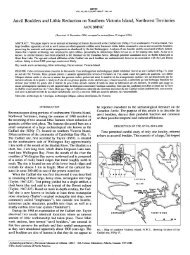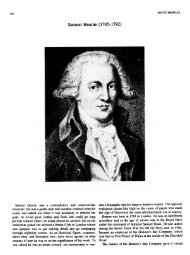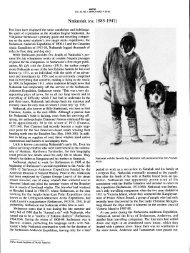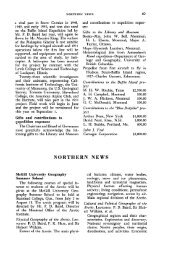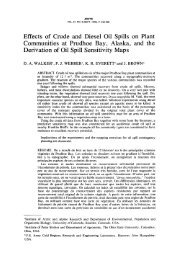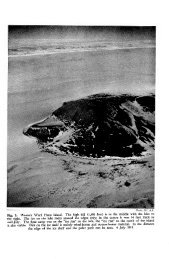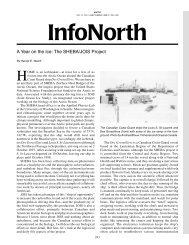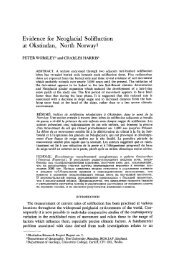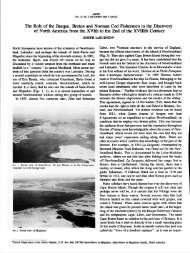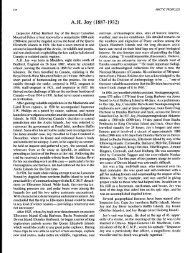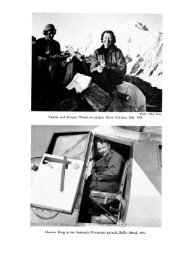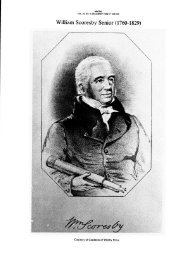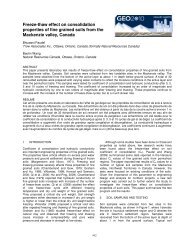NOTES ON THE NUNAMIUT ESKIMO AND MAMMALS OF ... - arctic
NOTES ON THE NUNAMIUT ESKIMO AND MAMMALS OF ... - arctic
NOTES ON THE NUNAMIUT ESKIMO AND MAMMALS OF ... - arctic
Create successful ePaper yourself
Turn your PDF publications into a flip-book with our unique Google optimized e-Paper software.
170 <strong>THE</strong> <strong>NUNAMIUT</strong> <strong>ESKIMO</strong> <strong>AND</strong> <strong>MAMMALS</strong> <strong>OF</strong> <strong>THE</strong> ANAKTUVUK PASS REGI<strong>ON</strong><br />
lunged at the hunter, it became impaled. Some bears were killed by bow and<br />
arrow. One man would infuriate the bear until it charged him, and he would<br />
then lead it past the hunters in ambush.<br />
Grizzlies were killed in the winter whenever one could be found in a den.<br />
Before an effort was made to kill the bear, the hunters used to defecate upon<br />
the earth dug from the den. They believed that doing so would ensure their<br />
finding a bear inside. For killing the bear, a triangular frame was prepared<br />
by binding together three heavy willow sticks, with a fourth placed from the<br />
base to the apex to give additional strength. The apex of this frame was<br />
inserted into the den mouth, and a certain phrase (“Nmi kamna”, meaning<br />
approximately “Is anything in?”) was called out. The aroused bear would<br />
seize the wood and try to pull it into the den, and while thus occupied it was<br />
speared. These customs are no longer followed.<br />
In timbered country bears were sometimes snared. A noose was placed<br />
above the trail, with the line running upward over a branch of a tree or through<br />
a hole in the tree itself. This line was attached to a very heavy log carefully<br />
balanced on end against the far side of the tree. When the bear pulled against<br />
the noose, the log was dislodged and its weight tightened the loop.<br />
It is of interest that the Nunamiut have no knowledge of the breeding<br />
habits of the grizzly bear, and there is considerable speculation as to breeding<br />
time. An Eskimo named Tumaitchak, who was supposed to have killed more<br />
than 40 bears, observed a bear around the mouth of a den in December. The<br />
hunters went after this animal and killed it; it was found that it had just given<br />
birth to a cub. Twin cubs are the rule.<br />
A. Murie (1944) has reported various observations on the relationship<br />
of wolves and grizzly bears. In the Brooks Range there appears to be frequent<br />
friction, resulting at times in actual combat. One of the Nunamiut, Kakinya,<br />
in the spring of 1939, came upon a bear and shot it. When he fired, three<br />
wolves, -which he had not seen, ran out from nearby and escaped. Upon<br />
skinning the bear, he found it to have been severely bitten around the back<br />
and rump. It is not unusual for bears to drive wolves from their kills, but<br />
the bears seem to show fear of wolves. In early October 1950 I observed<br />
from the tracks that an adult bear sleeping in a creek bed high on a mountain<br />
side had been disturbed by a very large wolf. The bear left at a run and did<br />
not slow its pace until well down the mountain. Maptigak said that wolves<br />
often chase bears, and that bears always show fear of wolves. Arthur O’Connell,<br />
who has trapped for many years along the North Fork, stated that he has<br />
seen evidence of bear-wolf fights, and has found wolves killed by bears.<br />
As far as can be judged from available information and personal observations,<br />
the numerical status of the <strong>arctic</strong> grizzly is good. Very old bears are not<br />
uncommon, indicating that these animals live, in general, unmolested. The<br />
Nunamiut do not recognize any decline in numbers, and in view of the<br />
relatively small region over which they hunt, they can have little effect upon<br />
the over-all bear population. It is unlikely that this animal will suffer a serious<br />
reduction in numbers<br />
the white man.<br />
unless they are subjected to considerable hunting by



